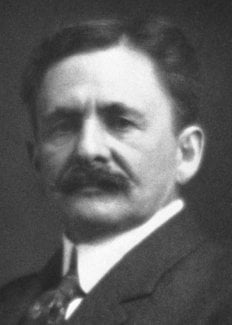Albert A. Michelson
Biographical

Albert Abraham Michelson was born in Strelno, Prussia, on December 19, 1852. Two years later his family emigrated to the United States to settle at Virginia City, Nevada, but they eventually moved to San Francisco where Michelson received his early education in public schools, matriculating from the High School in 1869. He was appointed by President Grant to the U.S. Naval Academy and, after graduation as Ensign in 1873 and a two-years’ cruise in the West Indies, he became an instructor in physics and chemistry at the Academy under Admiral Sampson. In 1879, he was posted to the Nautical Almanac Office, Washington, to work with Simon Newcomb, but in the following year, he obtained leave of absence to continue his studies in Europe. He visited the Universities of Berlin and Heidelberg, and the College de France and École Polytechnique in Paris. He resigned from the Navy and in 1883 returned to America to take an appointment as Professor of Physics in the Case School of Applied Science, Cleveland, Ohio. In 1890 he accepted a similar position at Clark University, Worcester, Massachusetts, and in 1892 he became Professor of Physics and the first Head of Department at the new University of Chicago. He rejoined the Navy during World War I, and in 1918 returned to Chicago where in 1925 he was appointed to the first of the Distinguished Service Professorships. Michelson resigned in 1929 to work at the Mount Wilson Observatory, Pasadena.
During his career, Michelson touched on many departments of physics but, perhaps due to a special instinct which he appeared to possess, he excelled in optics. He performed early measurements of the velocity of light with amazing delicacy and in 1881 he invented his interferometer for the purpose of discovering the effect of the Earth’s motion on the observed velocity. In cooperation with Professor E.W. Morley, and using the interferometer, it was shown that light travels at a constant speed in all inertial systems of reference. The instrument also enabled distances to be measured with greater accuracy by means of the length of light-waves. At the request of the International Committee of Weights and Measures, Michelson measured the standard metre in terms of wavelength of cadmium light. He invented the echelon spectroscope and during his wartime service in the Navy he performed research work on devices for naval use – he developed a rangefinder which was adapted as part of U.S. Navy equipment. On his return to civilian life, Michelson became more interested in astronomy and in 1920, using light interference and a highly developed version of his earlier instrument, he measured the diameter of the star Betelgeuse: this was the first determination of the size of a star that could be regarded as accurate.
Michelson has contributed numerous papers to many scientific periodicals and among his more substantial works are the classics, Velocity of Light (1902) Light Waves and their Uses (1899-1903); and Studies in Optics (1927).
Michelson was honoured by memberships of many learned societies throughout America and ten European countries, and he received honorary science and law degrees from ten American and foreign universities. He was President of the American Physical Society (1900), the American Association for the Advancement of Science (1910-1911), and the National Academy of Sciences (1923-1927). He was also a Fellow of the Royal Astronomical Society, the Royal Society of London and the Optical Society, an Associate of l’Académie Française and among the many awards he has received are the Matteucci Medal (Societá Italiana), 1904; Copley Medal (Royal Society), 1907; Elliot Cresson Medal (Franklin Institute), 1912; Draper Medal (National Academy of Sciences), 1916; Franklin Medal (Franklin Institute) and the Medal of the Royal Astronomical Society, 1923; and the Duddell Medal (Physical Society), 1929.
Michelson married Edna Stanton of Lake Forest, Illinois in 1899. They had one son and three daughters. He died in 1931.
This autobiography/biography was written at the time of the award and first published in the book series Les Prix Nobel. It was later edited and republished in Nobel Lectures. To cite this document, always state the source as shown above.
Albert A. Michelson died on 9 May 1931.
The Nobel Foundation's copyright has expired.Nobel Prizes and laureates
Six prizes were awarded for achievements that have conferred the greatest benefit to humankind. The 12 laureates' work and discoveries range from proteins' structures and machine learning to fighting for a world free of nuclear weapons.
See them all presented here.
